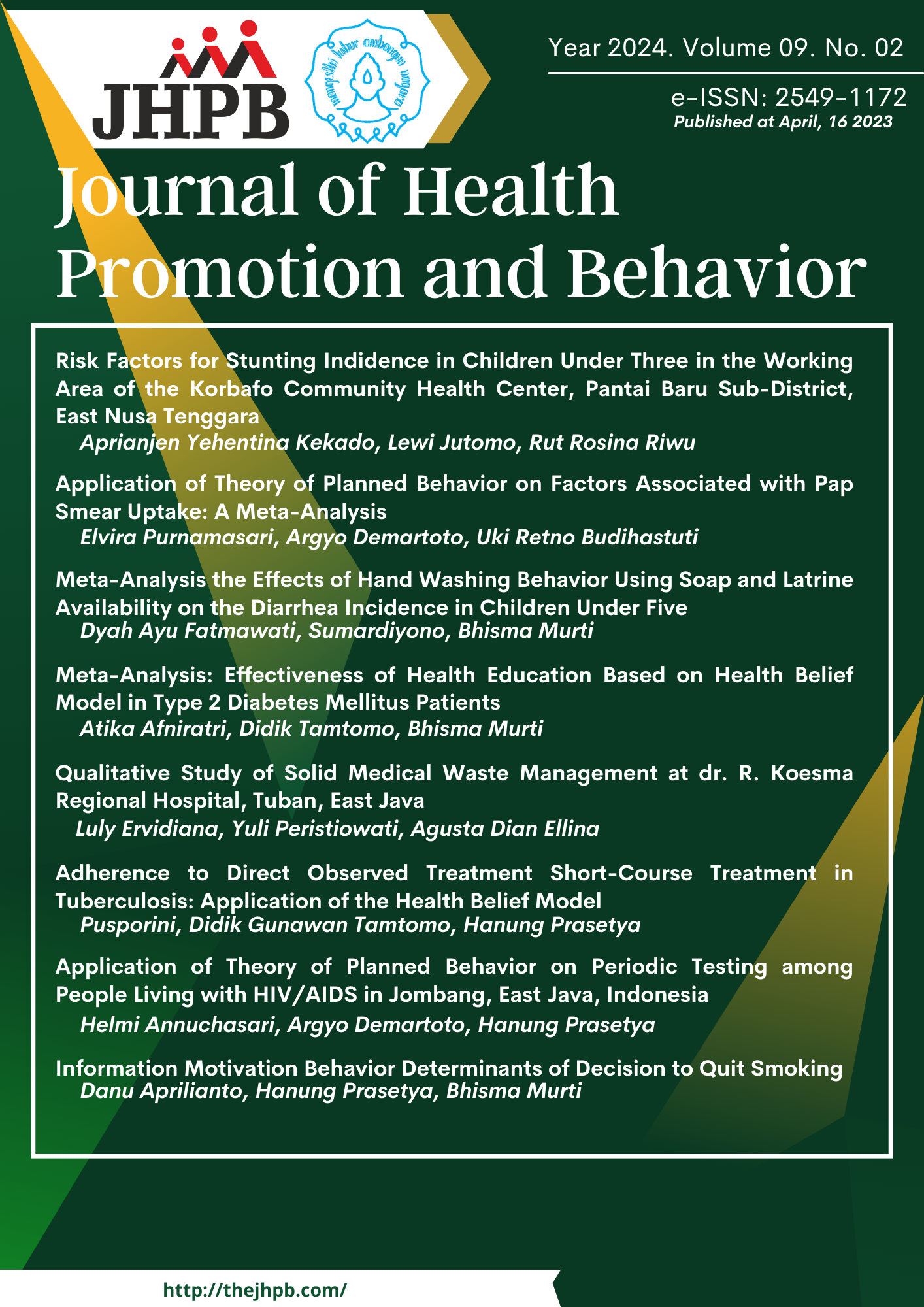Application of Theory of Planned Behavior on Periodic Testing among People Living with HIV/AIDS in Jombang, East Java, Indonesia
DOI:
https://doi.org/10.26911/thejhpb.2024.09.02.07Abstract
Background: HIV/AIDS is one of the sexually transmitted diseases that is still high in the world. As many as 650,000 people died from this disease, around 38.4 million people were living with HIV/AIDS (PLWHA), by the end of 2021 with 1.5 million people newly infected with HIV. This study aimed to explore the behavior of people with HIV/AIDS based on the theory of planned behavior.
Subjects and Method: A qualitative design with a case study approach was conducted at the Jombang District Health Service, Jombang Care Center, and the Kabuh Community Health Center Work Area. A total of 5 key informants, 10 people with HIV/AIDS as main informants, 1 supporting informant were selected purposively and snowballed. Data collection was carried out by interviews, observation, documentation (taking photos and reviewing control cards of people with HIV/AIDS). Data were analyzed using the Miles and Huberman method.
Results: Behavioral intentions are related to the behavior of regular examinations in PLWHA. Attitudes are related to the behavior of regular examinations of PLWHA. Subjective norms are related to the behavior of regular examinations in PLWHA. Perceived behavioral control is related to the behavior of periodic examinations of PLWHA in Jombang Regency, East Java.
Conclusion: Informants have high intentions or positive intentions to carry out periodic examinations aimed at maintaining their health so that it is much better. Informants accept and believe that with regular check-ups their body condition and health will be much better. The role of family and peer support groups is stronger than the influence of health workers. All key informants had positive control behavior to carry out examinations at community health centers that were not close to where they lived when the service from health workers was non-discriminatory and provided accurate information.
Keywords:
theory of planned behavior, periodic inspection, PLWH, HIV, AIDSHow to Cite
References
Ali B, Nisar N, Nawab F (2018). Adherence to antiretroviral therapy in HIV-positive, male intravenous drug users in Pakistan. East Meditter Health J. 24(3): 237-242. Doi: 10.26719/2018.-24.3.237.
Ajzen I (2020). The theory of planned behavior frequently asks questions. Hum. Behav. Emerg Technol. 2(4): 31-4-324. doi: 10.1002/hbe2.195.
Ajzen I (2002). Perceived behavioral control, self-efficacy, locus of control, and the theory of planned behavior. J Appl Soc Psychol. 32(4): 665-683. Doi: 10.111-1/j.1559-1816.2002.tb00-236.x.
Ajzen I (2005). Attitudes, Personality, and Behavior. 2nd Edition. New York: Open University Press.
Borah P, Xiao X, Lee DKL (2022). Narrative messages, information seeking and COVID-19 vaccine intention: The moderating role of perceived behavioral control. Am J Health Promot. 36(6): 923-933. Doi: 10.1177/089011-71221075019.
Dumitrescu AL, Wagle M, Dogaru BC, Manolescu B (2011). Modeling the theory of planned behavior for intervention to improve oral health behaviors: the impact of attitudes, knowledge, and current behavior. J Oral Sci. 53(3): 369-77. Doi: 10.2334/josnusd.53.369.
Fishbein MA, Ajzen I (1975). Belief attitude, intention, and behavior: an introduction to theory and research. Boston: Addison-Wesley
Handayani TP, Shaluhiyah Z, Mustofa SB (2015). Perilaku ODHA dalam peme-riksaan berkala sebagai upaya perawatan dan dukungan (care and support) di Kabupaten Pemalang. Indonesia. J. Health Promotion. 10(2): 193-206. Doi: 10.14710/jpki.10.2.193-206
Husain F, Shahnawaz M, Khan N (2021). Intention to get COVID-19: Exploring the role of attitudes, subjective norms, perceived behavioral control, belief in COVID-19 misinformation, and vaccine confidence in Northen India. Hum Vaccin Immunother. 17(11): 3941-3953. Doi: 10.1080/21645515.2021.19-67039
Isnaini SA, Karyus A, Setiaji B, Pramudho K, Budiati E (2023). Faktor yang ber-hubungan dengan kepatuhan minum obat ARV pasien HIV rawat jalan. J. Ilmiah Permas. 13(4): 1577-1586. Doi: 10.32583/pskm.v13i4.1390.
Kemenkes RI (2021). Buku hari AIDS sedunia (World AIDS day book). Direktorat jenderal pencegahan dan pengendalian penyakit. Jakarta: Kementerian Kesehatan Replubik Indonesia.
Kemenkes RI (2021). Laporan perkem-bangan HIV/AIDS dan penyakit infeksi menular seksual (PIMS) Tri-wulan I Tahun 2021 (Report on the development of HIV/AIDS and sexually transmitted infections (PIMS) for the first quarter of 2021). Jakarta: Direktorat Jenderal Pencegahan dan Pengendalian Penyakit.
Kemenkes RI (2022). Profil Kesehatan Re-publik Indonesia Tahun 2021.
Li M, Li N (2023). A study of the factors influencing HIV-preventive interactions among “hookup” application users. Front Psychol. 1-23. Doi: 10.3389/fpsyg.2022.1048226.
Miles BM, Huberman M (1992). Analisis data kualitatif buku sumber tentang metode-metode baru (Qualitative data analysis of source books on new methods). Jakarta: UIP.
Nurmawanti T, Sari YK, Hidayat AP. (2019). Hubungan antara lama pengobatan dengan jumlah CD4 pada penderita HIV/AIDS yang menjalankan program pengobatan antiretroviral (ARV). J. Ners Midwife. 6(2): 197-202. Doi: 10.26699/jnk.v6i2.artp197-202.
Ntsabane M, Letamo G, Keetile M. (2023). Factors associated with low uptake of safe male circumcision (SMC) and the intention not to undergo circumcision among men in Botswana. J Public Health. Doi: 10.1007/s10389-023-02-0-28-7.
Rijali A (2018). Analisis data kualitatif. Alhadharah. 17(33): 81-95. Doi: 10.18-592/alhadharah.v17i33.2374.
Saputri LD, Widiyaningsih V, Prasetya H (2023). Effect of injecting drug user on the risk of Human Immunodeficiency Virus/Acquired Immunodeficiency Syndrome: A meta-analysis. J Epidemiol Public Health. 8(1): 77-87. Doi: 10.2911/jepublichealth.2023.08.01.07.
Tenkorang S, Doe KB, Adu J (2022). Patronage Of HIV/AIDS Voluntary Coun-selling And Testing (VCT) Among University Students In Ghana. S Afr J Educ. 8(6): 1-16. https://doi.org/-10.47604/ajep.1664.
Tsegaw A, Kassie A, Alemnew W. (2022). Motivational factors influencing readiness to use youth-friendly services among secondary school students in East Belesa district, using the Theory of Planned Behavior. Research Square. 16. Doi: 10.21203/rs.3.rs-200921-7/v1.
UNAIDS (2023). HIV and AIDS - basic facts. Swiss: United Nations Program on HIV/AIDS. https://www.-unaids.org/en/frequently-asked-questions-about-hiv-and-aids.
Qing L, Wang Y, Yang T, Chen X, Zhang M, Bu Q, Tan B, et al. (2022). Study on HIV/AIDS knowledge, sexual attitudes, sexual behaviors, and preventive services among young students in Chongqing, China. Front Public Health. 1-12. Doi: 10.3389/fpubh.2022.982727.
World Health Organization (2021). Consolidated guidelines on HIV prevention, testing, treatment, service delivery, and monitoring: recommendations for a public health approach. https://-www.who.int/publications/i/item/9789240031593.





